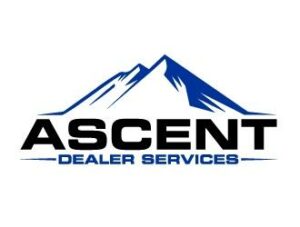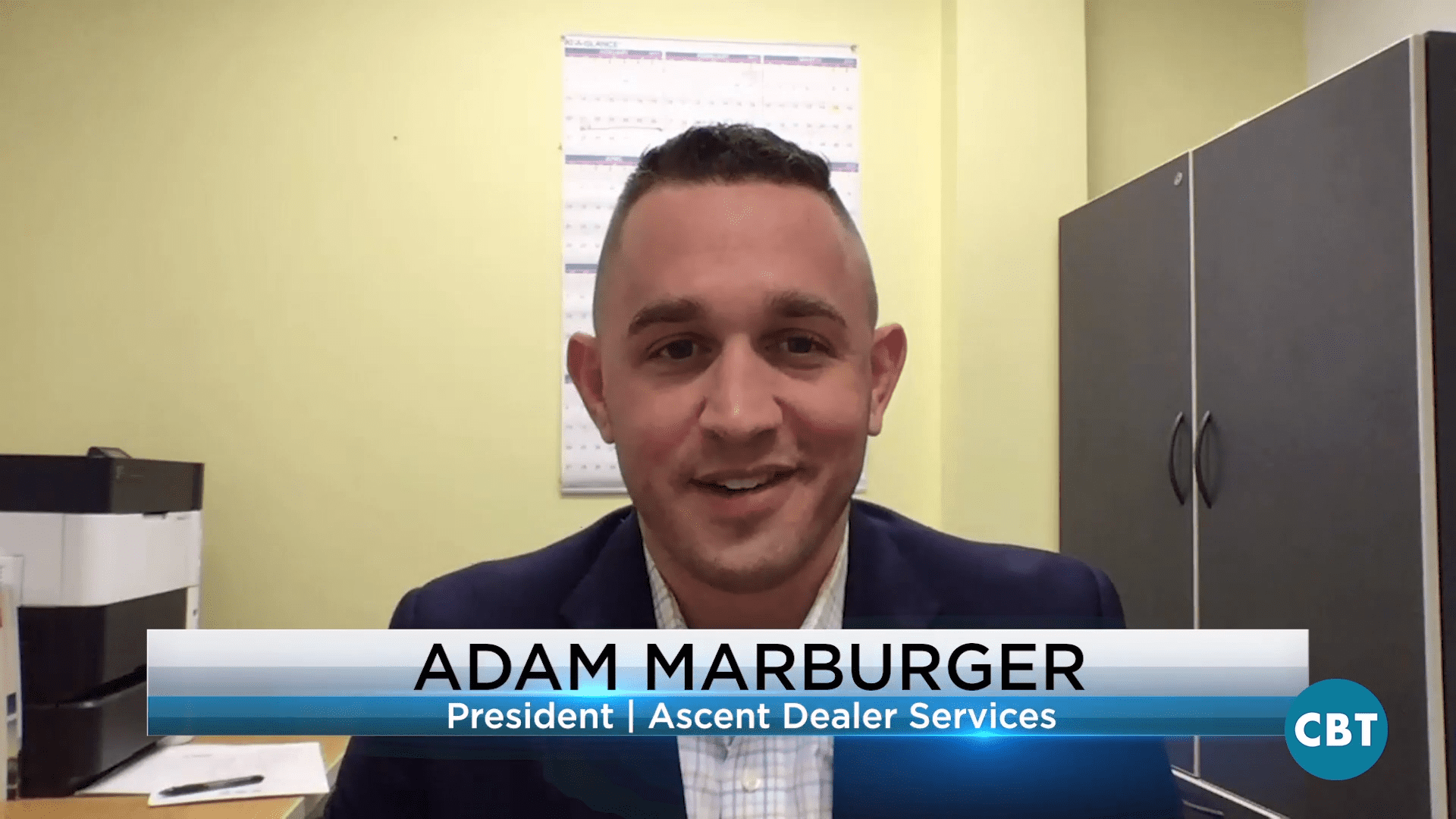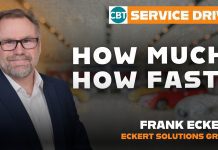On today’s show, we welcome back Adam Marburger, F&I expert, and President of Ascent Dealer Services. Adam always has great insight into what makes a successful F&I office and what dealers could be doing more of in their day-to-day.
 VIDEO TRANSCRIPT:
VIDEO TRANSCRIPT:
Jim Fitzpatrick: We are so excited to have Mr. Adam Marburger, who’s President of Ascent Dealer Services, back with us on today’s show. Adam comes to us with a tremendous amount of experience in driving more profits to the F&I department for dealers nationwide. Adam, thank you so much for joining us on CBT News.
Adam Marburger: Glad to be here, as always. Thank you very, very much for having me.
Jim Fitzpatrick: Sure, let’s kind of jump right in. What are some of the biggest, I mean, you’re working with dealers all over the country, and I know you’re so busy building your company and working with dealers. What are some of the biggest issues that you find out there, facing F&I offices today?
Adam Marburger: So the biggest issue that I’m seeing, as of recent, is lack of coaching and training. So when a dealer calls me, it’s because they’re not getting the support they feel they deserve from their F&I product provider.
So I’m seeing a very, very big need for coaching and training, and so that’s where I’m getting the majority of my leads. I’ve got dealers reaching out to me, personally, because they need coaching and training.
Jim Fitzpatrick: Right, right. Yeah, and that’s just ongoing, isn’t it? I mean, that-
Adam Marburger: Absolutely.
Jim Fitzpatrick: Seems to be something that dealers were always struggling with, is whether they hired a new sales, I mean, a new F&I manager. Or, they’ve got one that’s kind of falling off the program a little bit, and kind of gotten a little bit comfortable in their ways, and not sticking to the block and tackle, and some of the basics that have to take place at an F&I office. You help the dealers with that, right?
Adam Marburger: Absolutely. And it all boils down to your process, so if we have a great process, and then we have somebody to hold them accountable, then you’re going to see results. But if an F&I manager goes rogue, and does it maybe their way, and their way may not be the most profitable way or the most efficient way. And then if you don’t have anybody holding them accountable, that’s a mess.
Jim Fitzpatrick: Right. Is it conceivable to think that every store should be running it at 1,500 a copy, or better in F&I today?
Adam Marburger: So the number on the street all over the country is 1,500 bucks a car. I don’t, I’m not going to say I disagree with that, but I will tell you, there’s markets that are massively different. St. Louis is different from Denver, Colorado. Southern California’s different from Texas. So you see some markets where PVR creeps up to that $2,000 a transaction, but then you see markets where you’re barely getting to a 1,000 a transaction.
I mean, up in Detroit, I was there earlier in the week, and they’re 70%, the store I was at, 70% lease. And at this Ford dealership, it’s all planned business, it’s all family plans. So it’s going to be very difficult for that dealer to get the $1,500 of transaction. So I would say, that it depends on your market. Every market’s a little bit different.
Jim Fitzpatrick: Right. And for dealers that are sitting at, let’s say, 1,200 or 1,300, what’s the best way for them to pick up that extra couple of hundred bucks a copy?
Adam Marburger: Anytime anyone ever asks that question, that question gets asked a lot. You got to look at your service contract. The quickest way to get a couple hundred dollar lift in PVR, is to look at your service contract penetration, and then look at your gross per service contract. You can look at those two things, and engage them, and get the necessary increments. That’s exactly how you can raise PVR, is raise the price of your service contract, put some skills and some action in place, on how to increase the penetrations.
Jim Fitzpatrick: Right.
Adam Marburger: And then you’ll see your PVR raise.
Jim Fitzpatrick: Right. And just the 200 bucks a copy increase for a dealership that sells a 150 to 200 cars a month, over a 12 month period of time, you just added a lot to that dealer’s bottom line, without doing anything more than just training, right?
Adam Marburger: Amen, absolutely correct. They’re not spending any additional money, the same customers they already have, we’re getting a couple hundred a lift, and that’s the difference between some dealers being profitable or not profitable.
Jim Fitzpatrick: Adam, share with us what the top three things are for an F&I department to be successful.
Adam Marburger: Absolutely, so it takes a combination of these three things. So you got to have best in class products. You have to have A-type service contracts. You got to have the best products in the industry. And then you got have the right technology. Technology’s really important, especially today. And most importantly, you got to have the training and the coaching to support those. If you’ve got those three, you’re going to win in F&I.
Jim Fitzpatrick: Yep, absolutely. Let’s back up a minute and talk a little bit more about technology. What specifically do you mean when you say, “Technology?”
Adam Marburger: For instance, I’m here in Iowa right now, just launching a group, and they use Darwin, and Darwin’s just such a fantastic menu. It’s so user-friendly, the consumers like it. I mean, years ago, we were printing out paper menus, and some stores still do, and that’s okay. But it’s just nice to see some of these new features, docuPAD, being able to take an F&I manager, and put them on Reynolds docuPAD, it just does not allow for mistakes. So that’s a nice piece of technology. So things like that definitely help.
Jim Fitzpatrick: And then, of course, you mentioned the coaching. How often should an F&I manager be coached or be trained?
Adam Marburger: I think a professional should train every single day. I’m not saying there should be an in-store trainer there every day, but they should have some content and curriculum that they’re training on, on a daily basis, so if they’re trying to grow to that next level.
Now from a standpoint, I reach out, I touch almost every one of my managers on Monday, Wednesday, and Friday, via text, calls, Zooms, I’m always touching with my fellow managers. And just little, short bursts of training. I will never go into a store and hold an F&I manager up for two and three hours on a subject. I like the little, short bursts of training. “Here’s my subject matter for today. We’re going to get through this. I’m going to give you a task. We’re going to follow-up on this task.” So little bursts go a long way.
But that I think that an F&I professional should train on a daily basis. Whether it’s with another F&I manager, or a salesperson role playing, whether we’re going back as service to look an RO to see what’s really happening in their service department. There are a lot of things that we can do on a daily basis, and I think it’s on a daily basis, Jim, that we need to be training.
Jim Fitzpatrick: Yeah, for sure. Who should be dishing up the payment range to a customer? Should it be the desk manager or the F&I manager?
Adam Marburger: I think it should come from the desk. I mean, here I like with technology, the way it is now, I mean, it’s real easy for the desk to send out a pencil with all the disclosures. Some stores I see the difference into the box type clothes. I mean, it works for some of the small town dealers, but I will tell you, that if a customer comes into the finance office, and they said yes to the car, but they’re $200 away on payment, you just wasted everybody’s time. So I think it’s a good idea for the desk manager and the sales consultant to dish out those numbers, and disclose upfront. So I think it’s a joint effort, but I think the sales desk should dish out, I like the tower sending out the first pencil.
Jim Fitzpatrick: Yeah. And should there be any leg in that number for the F&I manager?
Adam Marburger: Absolutely not. No way. Leg is a thing of the past. And you know what, for those that still do that, I think it’s a sign of weakness, to be honest.
Jim Fitzpatrick: It’s the old F&I guy in me, sorry about that.
Adam Marburger: Yeah, but at the end of the day, the customer knows more than we do sometimes.
Jim Fitzpatrick: Yeah.
Adam Marburger: Let’s be very transparent, let’s be open, and let’s build relationships. We want the customer, see everybody’s like, “Here, we need to sell a car today, but more importantly, we need to sell a car tomorrow.”
Jim Fitzpatrick: The importance of F&I managers conducting good customer interviews, talk to us about that.
Adam Marburger: So I like to call it first impression. So I think it needs to be the F&I manager’s first impression. We can go into the interview and needs analysis, but it’s extremely important for that F&I manager to build the relationship.
I always ask, “What brought you to my dealership today, Mr. Customer? What were you trying to accomplish?” Get the customer to open up, it’s that relationship-building that’s the most important part.
Jim Fitzpatrick: Right.
Adam Marburger: I was just telling my team over here, “That you could forget all of your word tracks, you could forget how long the customer is going to keep their car, you could forget how many miles they drive a year, but if they like you, you’re going to overcome it. “If they don’t like you, you’re going to struggle.”
Jim Fitzpatrick: That’s right.
Adam Marburger: So I think that first impression, letting your consumer know you’re trying to serve them. It’s about serving our consumer. Sell more products and services.
Jim Fitzpatrick: Yep, I agree. I agree. Adam Marburger, F&I expert, and Founder of Ascent Dealer Services, I want to thank you so much for joining us on CBT News. This has been very informative. I’d love to have you back to cover some more of these topics that affect F&I manager.
Adam Marburger: Would love to, anytime. I’m here for you, my friend.
Jim Fitzpatrick: Great. Thanks so much.








